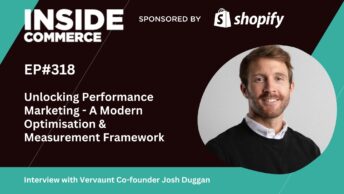Grab your chance to learn how to master ISNO from Michael Robinson, the ecommerce retail leader who launched and grew Anthropologie.com into a $200m+ online retailer and founded Sweft, and James Brooke, ex-founder / CEO of Amplience, who scaled them into a market leading global DXP.
Watch the video
Listen on your favourite player
In this episode we cover a hugely important topic, one that affects pretty much all retailers: maximising inventory availability online and reducing ISNO issues.
Getting stock online is harder than it seems! For many businesses, siloed processes and technology result in inefficiency and slow down the speed to market for new products and range launches. Not to mention the sheer number of spreadsheets and manual effort involved to move products from one stage to the next.
The longer a product remains offline, the greater the margin loss because the window of full price opportunity shrinks.
We share the combined experience of two ecommerce leaders who are helping ecommerce retailers improve automation and join the dots to speed-up product launches and minimises the number of products that are in stock but not available to buy on the website.
Key discussion points
- Let’s start with the operational concern here: why does ISNO exist, what are the typical systems and process issues that hamper ecommerce teams when trying to maximise inventory availability & speed up launch times?
- How much is it down to silos and systems vs. business culture issues in not taking this seriously?
- This is most relevant to brands that frequently put large volumes of new SKUs online, so let’s look at this commercially, why should people care: trading is tough, focus will be elsewhere right now.
- I saw a stat from you stating that each day a product is ISNO it loses 1-2% of full price sales, costing $millions in margin erosion: the ecom industry is healthily sceptical of bold claims, can you substantiate that for us please
- Let’s put a Sweft lens on this: what product workflows do you automate natively, and what manual processes are you typically removing?
- And let’s help our listeners understand how you fit into the wider ecom stack: we’re talking about product data management but this isn’t a PIM, how does Sweft work in conjunction with a PIM like Akeneo, Pimberly etc.?
- Many businesses still rely on manual process and spreadsheets, because it works even if it’s inefficient: how do you tackle resistance to change & the risk of change when pitching?
- Let’s finish on your roadmap: what are you most proud of from the 2023 releases and what new features are planned for 2024 that will interest your customers?
Want to suggest a topic or guest for a future episode? Contact us via the website or on LinkedIn.





